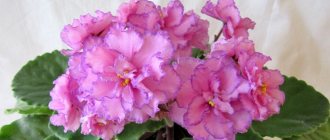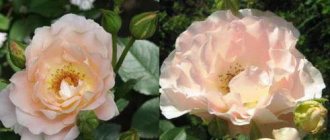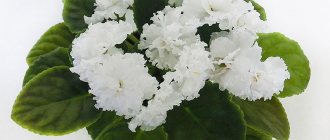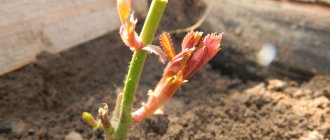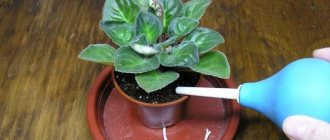Botanical description of the plant
Violet is a plant up to 35 cm high with a compact rosette of bright green, moderately dense leaves. The leaves of the Malachite Rose have pronounced waviness, veining and a slight edge. The leaf blades are rounded and elongated on short light emerald petioles.
The flowers are large, reaching 5 cm in diameter. Having blossomed, the double violet takes the shape of a five-pointed star. They have a light pink color with an ashy tint. A distinctive feature is a lush, wide greenish border, which emphasizes the tenderness of the flower. During the peak flowering period, peduncles on flexible stems bend towards the leaves under the weight of the inflorescence, which numbers up to 5 copies.
Basic conditions for growing violets
Violet Malachite Rose is a fairly unpretentious variety. Quite calmly tolerates short-term dryness, which can occur during a long absence of the owner. Having decided to grow this variety, you need to be patient - the flower grows very slowly. Prefers diffused daylight. In cool conditions, leaf variegation increases. The variety is suitable for those who are just starting to grow Saintpaulia.
One of the main conditions for the lush flowering of the Malachite rose is the microclimate. When growing this variety, it is necessary to control 3 main parameters: humidity level, lighting and temperature. Placement and lighting
The optimal lighting level is bright, diffused light. The best place to grow this variety is the window sill located on the east or west side. If the flower is on the south side, it is recommended to cover the window with a light cloth. The duration of daylight for this plant should be no more than 14 hours. In winter, it is recommended to use special biolamps.
Temperature and humidity
For violets of this variety, the optimal temperature range varies between 18-24°C. It should not be allowed to drop to 15 degrees. This can cause the death of the plant. Sudden changes in temperature are also contraindicated. Place. Where the flower stands should be protected from drafts.
The optimal humidity level is at least 50%. Dry air will negatively affect growth and development. In this case, moisturizing with a spray bottle is contraindicated. To maintain the indicator within normal limits, you can use a humidifier.
Signs depending on the type of violets
There are special signs that explain the effect of a flower with petals of a certain shade.
White
The color is associated with purity and innocence. Such plants improve the child’s well-being. White symbolizes newness, bright, sincere feelings. For many, this shade represents the bride's outfit.
White Saintpaulias encourage you to keep your space clean and tidy. They eliminate unpleasant thoughts and neutralize conflicts. Such plants calm, help avoid nervous breakdowns, worries, and smooth out conflicts.
Pink
Such viols relieve obsessive thoughts and help avoid perversions in sex. Pink violets are good helpers in the fight for a slim figure. They can be used as a means for active action. Growing such flowers is useful for boosting immunity.
Blue
A delicate heavenly shade awakens creativity. Such plants inspire and help reveal talents. They are useful to grow if you need to learn drawing or master a musical instrument. Blue helps get rid of melancholy and boredom. Such violets give joy, awaken family feelings, and help establish communication.
Purple
It is useful to grow violets of this shade to create a favorable atmosphere in the apartment. This color neutralizes negativity and turns it into positive energy. Purple varieties eliminate misunderstandings between household members, neutralize aggressive attitudes and remove feelings of competition. These Saintpaulias increase resistance to troubles.
Red or burgundy
This color symbolizes passion. Violas with red petals, recently purchased, awaken love. Another effect of such plants is to improve material well-being. If the red violet blooms, the streak of lack of money is over.
Lilac
Flowering varieties with petals of this shade foreshadow a fateful meeting.
Pansies
This is what tricolor violas are called. They have bright petals, with centers reminiscent of eyes. Pansies bring joy and optimism, relieve bad mood.
It is especially useful to inhale their aroma to relieve headaches and cough.
How to care at home
Caring for this variety of violet includes watering, shaping, timely application of fertilizing and replanting.
Watering
Violet Malachite Rose is a moisture-loving plant, so special attention must be paid to watering. Overdrying, as well as overwatering, can negatively affect growth and vegetation. It is recommended to water the violet no more than 2 times a week. For this purpose, use warm, settled water. The most effective and affordable way is to pour water along the edge of the pot, so that moisture should not get on any part of the plant.
Flower growers recommend strictly adhering to three basic rules when watering violets:
- the soil should be moist, but stagnation of moisture should absolutely not be allowed;
- it is necessary to carefully ensure that water does not get on the plant;
- Do not use hot or cold water for irrigation.
Violet lovers use several watering methods:
- along the edge of the container (twice a week);
- through the drainage holes from below (2 times a month);
- wick, when a twisted rope is passed through the holes in the pot, and the other end is placed in a container of water (this option is often used when you need to leave for a long time).
Violet malachite rose requires watering, this can be done using the wick method.
The frequency of watering is determined depending on the microclimate in the room, which affects the rate of soil drying.
Fertilizer application
The plant of this variety requires regular fertilization. For normal growth and development, it is imperative to maintain a balance of phosphorus, potassium and nitrogen, as well as other microelements. Without fertilizing, the Malachite rose will have to wait a long time to bloom. In addition, the plant will grow green mass very slowly.
Fertilizers are used during active growth and vegetation. The flower should be fed 2 times a month. In gardening centers you can purchase products designed specifically for violets, which contain a balanced composition of all microelements necessary for growth.
It is strictly not recommended to apply fertilizers: in case of microclimate disturbance, 1 month after planting, and also when the plant is affected by a disease.
Is it possible to keep violets in the house?
Although there are many beliefs about the negative effects of indoor Saintpaulias, their cultivation should not be treated poorly. You can grow several plants in an apartment without fear of causing harm. You just need to find a suitable place for them.
Where is good to put
In a small apartment, densely packed with furniture, it is recommended to grow violets in white or blue tones. Standing in the corner of the room, they awaken creative energy and help you think in the right direction.
Violas with white or purple petals are more suitable for a child's room. Such plants suppress aggression and calm an overexcited child.
Saintpaulias in red tones are suitable for the living room. They decorate the main room in the house and attract the attention of guests. Such plants put you in a friendly mood and evoke positive thoughts.
Where is it bad to place why?
The viola is not suitable for the bedroom. This is due to the photosynthesis of the plant. In the dark, the plant absorbs oxygen, releasing carbon dioxide. Therefore, the next morning a person wakes up tired. Particularly sensitive people experience headaches.
It is not recommended to place saintpaulias in red tones in a children's room. They provoke excessive activity and aggression in the child.
Violets need sunlight to grow well. Therefore, you cannot place the pot in a dark room without windows. Also, do not place the plant in the bathroom.
If at work
Saintpaulias of pink and lilac shades will look good in a spacious office. They strengthen energy flows and set employees up for fruitful work.
Violas with white petals are appropriate in rooms where cleanliness is important, or in the playrooms of a kindergarten. They clear thoughts of negativity.
Red shaded Saintpaulias are good for public places. They fill you with energy.
If you need privacy while working, blue flowers are suitable. These plants are recommended to be placed on a desktop or in a small office.
Trimming
The bush is formed from three rows of leaves, pinching off the leaf plates from below along with the petioles.
Also remove faded foliage and flowers. Pinching is carried out as needed.
Transfer
It is recommended to replant the plant no more than once every 2 years in early spring. The flower is also moved to another pot if it begins to fade, as this can be caused by improperly selected soil mixture or disease. This event will save the plant. The soil for Saintpaulias must be loose to allow enough air to pass through. In special garden centers you can buy a special soil mixture, or prepare it yourself.
The composition must contain:
- leaf soil - 3 parts;
- turf – 2 parts;
- peat and coniferous soil - 1 part each;
- coarse river sand;
- vermiculite;
- perlite;
- crushed sphagnum.
For replanting, it is also necessary to prepare a drainage mixture.
The transplant includes the following steps:
- Fill the container about a third full with drainage mixture.
- Pour the prepared soil mixture on top.
- Spill the soil in the pot where the flower is located and carefully remove it.
- Place the plant in prepared soil.
- Add substrate to the top edge of the pot.
- Water.
Violets require a small container. You can leave the flower in the same pot by simply changing the substrate. If the root system has grown greatly, it is necessary to use a new container, 2 cm larger in diameter than the previous one.
Reproduction
Violet Malachite Rose reproduces in several ways: by seeds, by dividing an adult bush and by cuttings. Any of these methods allows you to preserve the varietal characteristics of the plant. The easiest way is cuttings. Even a novice florist can handle it.
Cuttings
The most common method of propagating Mlachite Rose is cuttings.
The method involves performing the following actions:
- Pinch off a leaf from an adult plant, leaving a cutting 4 cm long.
- Place the cutting in a container with clean water.
- Wait for roots to form.
- Transplant the cuttings into a pot with soil mixture for violets.
In some cases, the leaf is rooted immediately in the container. To do this, lay a drainage layer on its bottom and fill it with special soil. However, this method has a significant drawback - the process of root formation is not visible, so it is difficult to understand whether the cutting has taken root or not.
Dividing the bush
The bush can be divided if children have formed on it.
The reproduction process using this method includes the following steps:
- Carefully remove the plant from the container.
- Clear the root system from the soil.
- Divide the rhizome into rosettes.
- Place each in a separate container.
Using this method, Saintpaulia can be propagated even during the growing season. The main condition is that the plant must be healthy.
Seeds
Planting material can be purchased at a garden center or collected yourself.
Seed collection is carried out as follows:
- Transfer pollen from the stamen to the pistil using a toothpick.
- After about a week, the ovary of the seed box is formed.
- The seeds will ripen after six months.
- Remove the dried box and open it.
- Remove the seeds with tweezers or a needle and place them on a sheet of paper.
Landing occurs as follows:
- Pour soil for violets into a pot that is not deep and wide enough.
- Make small indentations on the surface.
- Mix the seeds with sand and spread evenly into the formed depressions.
- Cover the crops with glass or film.
- Leave the container in a fairly bright place where the temperature does not exceed +25 and does not fall below +22 C.
- Regularly open the shelter and moisten the substrate with a spray bottle.
When the seedlings reach a height of 5 mm, they are dived into another container, maintaining an interval of 2 cm. Add a small amount of coal to the soil. Replant using a match or toothpick.
LiveInternetLiveInternet
Quote from Galyshenka's message
Read in full In your quotation book or community!
Bouquet of violets “From the most humble flower I will turn into the most proud...”
Eva Gonzalez
Is modesty decorative? If we are talking about a little violet hiding its violet eyes in the green spring grass, then modesty only emphasizes its delicate beauty. Violets arose from Adam’s tears of gratitude when, while he was on the island of Ceylon, the Archangel Gabriel brought him the joyful news that the Lord had forgiven him of his sins. For Christians, the violet is considered a symbol of humility. With all her appearance, she seems to be saying that life should pass unnoticed, in the pursuit of God.
Joseph Evstafievich Krachkovsky, Violets, 1902
In Ancient Greece, it was considered the flower of Persephone. One day while walking, she saw lovely violets on the slope. The girl sat down on the grass and began to examine her find. Unable to resist the charm of the delicious violets, Persephone decided to decorate herself with them and picked several flowers. Hades, the ruler of the underworld of the dead, passing by, saw a beauty admiring the flowers and decided to make her his wife. Persephone was afraid of the gloomy Hades and did not want to go with him. Then God picked her up in his arms and, despite the resistance, carried her to his kingdom of silence and eternal peace. Demeter, Persephone's mother, waited for her daughter for a long time, and, without waiting, rushed in search. Crumpled violets, still preserving the aroma of Persephone’s gentle breath, found by the unfortunate mother at the entrance to the underworld of Hades, revealed to her the secret of her daughter’s abduction. Demeter begged, asking Zeus to free her daughter from the kingdom of the dead, but Zeus did not want to quarrel with the harsh Hades and decided that Persephone would live with her mother for two thirds of the year, enjoying the sun and light, and spend the remaining third, as the queen of the world of the dead, with her husband . And so it has been since then - Persephone goes into the underworld - and nature falls asleep without her, the leaves fly off, the flowers wither. But as soon as her tender feet run out of the halls of Hades, everything around her joyfully comes to life. And from that moment on, fragrant violets are considered a symbol of dying and ever-resurrecting nature.
John William Godward
The Greeks considered the violet a flower of sadness, although they loved and revered it. There were entire violet plantations around Athens. The Romans loved the violet no less, considering it the flower of Jupiter himself. Not a single holiday was complete without her. Poets sang about her. They decorated statues and their heads with wreaths of violets. She was depicted on coins. True, there were also practical individuals, such as Pliny, who believed that olive groves should be planted instead of violet plantations...
Gelena Nikolaevna Pavlenko, Morning chill
The Gauls adored the violet. The French still love her. The violet was sung more than once by French poets, and the poet Desmarets, who lived during the reign of Louis XIV, sending a wreath of violets to the famous founder of literary evenings, Julie de Rambouillet, makes this flower say the following about itself: “Without ambition, I hide in the grass, modest in my coloring, I am also modest in choosing a place; but if I ever see myself on your brow, then from the most humble flower I will turn into the proudest.”
John William Godward
Jan France Portaels, Sicilian girl
Louis Hersent, Portrait of a young lady, 1830
Charles Bittinger, Afternoon Tea, 1912
The violet was the favorite flower of Josephine, Napoleon's wife. Josephine Beauharnais gave the violet a truly mystical meaning in her life. The story of her love for violets is touching and sad. Having come to power, Napoleon Bonaparte sent Josephine's husband, who was a supporter of the monarchy, to prison, and at the same time her. General Beauharnais was executed; few doubted that the same fate awaited his wife. But a miracle happened - the jailer’s daughter gave her a bouquet of violets. Who knows what Josephine was thinking, looking at the purple flowers and inhaling the forest scent, the scent of freedom in the dark walls of the prison.
Joseph Evstafievich Krachkovsky, Paris, 1902
The miracle continued - the next day the future empress was released. She returned to the prison gates on March 9, 1795 and somehow convinced the guards to give a pot of violets to the sick Dauphin, who was languishing in prison. Alas, the boy died a month later, he was buried at night, and someone planted violets on his grave. Josephine's flowers grew every year, and soon in the spring a purple carpet covered the entire grave of the unfortunate prince.
Henry James Johnstone (watercolor)
Gustav Igler, *****, 1888
Everything was going well for Josephine. She was invited to the ball. Dressed in a modest dress, the main decoration of which was live violets, she attracted the attention of Napoleon. From this evening her journey upward began. She became Napoleon's wife and empress. On the wedding day, at the request of his wife, Bonaparte always gave her violets.
Paul de Longpri, Still life with violets, 1895
Four years later, Napoleon came to Josephine with a bouquet of violets and a three-year-old son from another woman... This was their last meeting. After his death, on his chest, in a gold medallion, with which he never parted, they found two dried violets and a lock of blond hair - a memory of his morning and evening star - his dear Josephine and his no less dear son - the King of Rome. However, after Napoleon's death, the violet's mysterious connection with him does not stop. This flower continues to play its role in the fate of its descendants. On January 29, 1853, Eugenie became Empress of the French, appearing before Napoleon III with nothing less than a bouquet of violets on her hat or chest, in a lilac dress or with a veil the color of violets.
Empress Eugenie surrounded by ladies. . 1855
W. van Oudenrode, Still life
From then on, the violet became her favorite flower, and at the same time the flower of the whole fashionable world. Only these were no longer the modest violets of Josephine, but their ennobled appearance - Parma - with a darker color and a stronger smell. So these violets bloomed and fragrant like a flower of joy for more than 20 years, until on January 9, 1873 they turned again into a flower of death. On this day Napoleon III died - he died as an exile from his fatherland, in England. On January 14, in Chiselgerst, in the front hall, hung with coats of arms with the imperial crown and lined with countless candlesticks with brightly burning candles, Napoleon III lay in a coffin. A crucifix rested on his chest, and around his coffin in all sorts of forms: in wreaths, bouquets, garlands and even just scattered on the floor - there were violets sent from numerous friends and adherents of the Napoleonic dynasty from France. It was like the last greeting from his homeland...
Ruth Mercier, Still Life with Violets and Roses
Until now, on the name day of Empress Eugenie in Nice, where she constantly resides, the entire church is decorated with violets sent from all over France as a reminder that Napoleon’s faithful followers have not yet forgotten him. In addition, at the entrance to the church there are numerous sellers of violets, and not one of those going to the church will enter there without purchasing a bouquet.
Frans Mortelmans, Violets
Gabrielle Gilbert, Flower Seller
Churchill, Violets, 1905
Bouquet of flowers from Nice Music: Denes Buday Russian text: Lyudmila Glazkova from the film “Blumen aus Nizza” (Austria, 1936) Competitive performance on the television project “Big Opera” (TV “Culture”) Bouquet of flowers You sent it to me from Nice, and the lightning of days past is burning again. The violets whisper to me that the meadows are blooming again and that I am a little dear to someone.
Behmer Herman, What to write? A bouquet of flowers from Nice brought back dreams, reminded me of the pages of a bygone spring... And although there is no letter in the bouquet, no desired words, your love is hidden in the violets!
Charles Gates Sheldon stills from the film “Blumen aus Nizza” (Austria, 1936)
This is the curious role of the violet in the history of France, but this modest flower was loved in some other countries: loved by both sovereigns and poets, who more than once sang it in their verses. Shakespeare calls him his favorite, Shelley glorifies him in poems, Thomas Moore - in Lalla Rook, and Goethe not only glorifies him, but also tries to turn his hometown of Weimar, like Athens, which was continuous fields of these flowers, into a city , crowned with violets. Everywhere - near roads, in fields, in public parks, on the edges of forests - you can now find violets. People call them Goethe's violets, because the great poet had such a passionate love for this flower that he never went out for walks without taking violet seeds with him, which he then scattered along the way wherever he could. And now, although many years have passed without the poet, every spring the surroundings of Weimar turn into a luxurious carpet of violets - this is a memory of him that will remain for many decades and, perhaps, even outlive the glory of his creations.
Edouard Manet, Still life with a bouquet of violets and a fan
Our great writer I. S. Turgenev also loved them. While being treated in Wiesbaden, he walked every morning with a bouquet of fragrant violets, which he then invariably presented to G. Balashova, who was being treated at the same time as him. “These are my favorite flowers,” he told her, as she reports in one of the Moscow newspapers. “I feel a special pleasure in presenting them to you here every morning.” This is something outside of my course program. Don't tell anyone, anyone about this..."
Paul de Longpri, Violets in a glass goblet, 1896 Purple bouquet of surprised violets Looks like a purple sunset. Like a sunset, it shines wearily and a gentle aroma flows. Like the sunset, its fire is pitiful. Look at the small bush, There is no joy in the tender leaves of violets, There is a hidden, hidden sadness...
Lilla Cabot Perry
Lilla Cabot Perry, Portrait of Alice
Diseases and pests
Violation of the rules for caring for and growing violets of this variety can provoke the development of diseases and pest damage. If the plant begins to wilt, first of all it is necessary to adjust watering and fertilizing. Timely measures taken will allow you to quickly cope with the disease.
The main diseases of violet Malachite Rose:
| Disease | Causes | Signs |
| Fusarium | Decreased immunity as a result of stress makes the plant vulnerable to various pathogens. Penetrating into the root system, the fungi infect the conducting tissues and penetrate into the remaining parts of the flower. | At the initial stage of the disease, slow wilting of the violet is observed. The leaves begin to die. |
| Powdery mildew | The causative agents of this infection are parasitic fungi. The disease develops against the background of a decrease in temperature combined with high humidity, light deficiency, and an imbalance of microelements, when there is an excess of nitrogen and a lack of phosphorus and potassium. | A white coating appears on the green parts of the plant. Leaves curl, wither and fall off. The surface of the leaf blade becomes uneven and covered with ulcers. White spots form on flower petals. The development and growth of buds and shoots stops. Growth retardation and general depression are observed. |
| Late blight | The causative agent of the disease is a parasitic fungus. The disease is characterized by rapid spread. The main source of infection is infected soil mixture or planting material. The disease can be provoked by excessive watering, lack of lighting, and temperature fluctuations. | The plant, despite the moist soil in the pot, begins to fade. The root system changes color to brown, rots, partially or completely dies, gradually affecting the leaves and stem. Rapid drying of leaves. |
| Gray rot | The main routes of infection with an infectious fungal disease are through water or soil. The disease develops as a result of high humidity combined with low temperatures. Moisture entering the plant during watering. | The thinnest threads of mycelium are formed on the rosette. The leaves lose their elasticity and become lifeless. Their color changes and small brown spots appear. A fluffy moldy coating forms on the green parts of the plant and flowers. The affected areas soften, then dry out and die. |
| Rust | This disease can occur as a result of an excess of fertilizing, so it is important to strictly observe the proportions when applying fertilizers. This is also facilitated by increased room temperature and high humidity. | The leaves of Saintpaulia are the first to be affected. The leaf plates on the front and back sides become covered with a characteristic coating, and brown and yellow bulges form. |
| Bacteriosis | Often the cause of the disease is exposure to high temperatures. | The lower leaves become covered with a thin layer of mucus and gradually die off. |
Treatment of any fungal infection is carried out with fungicides. The drugs destroy fungal spores and counteract infections. If the disease cannot be eliminated, the plant is removed from the pot and burned. The soil in which it grew is also disposed of to prevent contamination of other specimens.
In addition to processing, plants need to change their growing conditions. As a rule, it is enough to reduce the humidity level by reducing watering, place the flower pot in a lighted and warm place, and also remove the top layer of soil where spores of parasitic fungi can live. Violets often suffer from insect pest attacks. They come in two types: leaf-eating and sucking.
The most common plant pests of this variety are:
- Ticks. This pest can be easily detected even without a microscope. In the green parts of the plant you can observe a scattering of red small dots surrounded by cobwebs. The leaves curl inward and subsequently wither and fall off.
- Thrips. You can tell that a plant is affected by this pest by the appearance of intermittent silvery leaves, or light yellow or colorless stripes on the outside of the leaves. Spots form on the surface of the affected leaf blades: light on the outside of the leaf and red-brown on the inside.
- Scale insects. Damage by this pest appears in the form of yellowish, greenish or brown tubercles on the reverse side of the leaf plate.
- Aphid. This pest is a sucking species. Causes damage to all parts of Saintpaulia: root system, stems, flowers. Infestation of a plant by a pest can be detected visually, since clusters of individuals are clearly visible to the naked eye.
- Nematodes. The pest lives in the ground. The root system affected by it is black or brown. The stem is thickened and elongated. There are no effective means to combat it. The only way to prevent infection is prevention. To do this, add marigold infusion or peat to the soil.
- Chervets. For violets, the root species are most dangerous. As a result of multiple damage to the roots, the plant’s immunity is significantly reduced, and it is not able to resist diseases. Ultimately it dies.
Insecticides are used to kill parasites. In this case, it is important to adjust the conditions of detention.
Signs and superstitions about violets
People say that indoor Saintpaulias influence the fate of the owner. Some are sure that the plant destroys personal life. Others are more positive. In their opinion, homemade violets bring only positivity and neutralize negative energy brought from the street.
Magical properties of the plant
Each flower has its own energetic qualities. There is a belief that the viola dies if trouble happens in the house or if troubles constantly occur. The plant seems to remove all negativity from the family.
Violas correspond to the zodiac sign Taurus. It is characterized by harmony, stability, and calm.
This flower has a calming effect on the psyche. But if the owner of the house is often irritated or emotionally unstable, the plant may dry out.
For unmarried girls
There are two directly opposite signs about violets in the house:
- This plant should not be grown by a girl if she plans to get married and have children. There is a belief that Saintpaulia destroys the personal life of an unmarried woman.
- A girl's marriage will be happy and prosperous if she receives a living violet as a gift. It is important that the donor is a friend with many children who is happy with her husband.
For women
There is a belief that Saintpaulia attracts troubles and misfortunes. This sign appeared more than a century ago, when in Europe the flower was planted in cemeteries. It was believed that the plant escorts the souls of the dead to the afterlife.
If the violet has dried up, there is no need to grieve. The plant saved the owner of the house from the damage caused to her. A woman needs to take a closer look at those around her in order to limit communication with negative people.
If the housewife finds one bud on a blooming violet that is different in color from the rest, this is a good omen. Soon a child will be born into the family.
For men
If after the man’s visit the violas growing in the house began to fade, the owners need to be careful. Perhaps the guest planned something unkind towards the household.
To find out how a woman he likes treats a man, he needs to give her a violet with white petals. If the plant feels good in her home, the beloved will feel sincere affection for it. Fading speaks of unstable feelings for a man.
In southern Italy, a small bouquet of violets is given to the groom. Choose plants with a dark core. They are believed to bring happiness and wealth to a young family.
For family
In Asian countries, lushly blooming violas are considered a positive sign. This flower brings happiness and harmony to spouses.
About health
Viola is classified as a medicinal plant. It is used in medicine, perfumery, and for preparing some culinary dishes. The leaves, roots and flowers of Saintpaulia contain useful substances, plant acids, and essential oils. Violets are used to make healing decoctions and infusions that help relieve inflammation, get rid of swelling, eliminate headaches, and improve sleep.
Viola is used to treat:
- atherosclerosis
- renal failure
- dermatitis
- rickets
- eczema
- scrofula
About money
To stabilize your financial situation and increase wealth, it is important to plant a flower correctly. Several yellow coins are placed at the bottom of the pot. If you are planning to start a large business, it is useful to purchase a viola with red or pink petals. Such a plant will attract good luck.
If the owner of the house is haunted by financial losses, losses, or large expenses, Saintpaulia with white buds will help. They ask for it as a gift or buy it themselves. When the plant blooms, the troubles will disappear.
About career
Growing Saintpaulia in the office always has a beneficial effect on the atmosphere between team members. The plant smoothes out tension and eliminates conflicts. If flowering has begun, colleagues are friendly towards each other. All started projects will be completed successfully.
Why does violet bloom?
Blooming buds on violas are a positive sign.
Family conflicts will stop, peace and mutual understanding will be established between spouses. A flowering plant creates a harmonious atmosphere, calms and reduces passions.
If flowers appear at the wrong time, the weather will soon change. In a sick person’s home, such an event foreshadows a quick recovery. According to another version, significant changes for the better will occur in the life of the family.
For single people, flowering promises an improvement in their financial situation.
Newlyweds - the birth of a child.
For spouses who have been married for a long time, improved relationships.
Why does it wither and dry out?
If indoor Saintpaulia dies without changing its care, one of the family members will get sick. The death of a plant promises a serious deterioration in health, financial difficulties, losses, unexpected expenses and other troubles.
Tips and tricks
Violet Malachite Rose is an unpretentious variety, but care requires strict adherence to certain conditions. Otherwise, Saintpaulia will die.
Experienced flower growers advise adhering to the following rules:
- The plant must be watered correctly by pouring water into the pan. It is not permissible to over-water the violet, otherwise it can cause rotting of the root system and cause the development of fungal diseases.
- The room temperature should not be more than 24 0C.
- During the growing season, it is important to provide good lighting.
- Apply fertilizing at least 2 times a month.
- Plant this plant in a pot of small depth and diameter. This is necessary so that the root system does not grow too quickly. Otherwise, they will take away most of the vitality of the flower, and you may not wait for flowering.
- Every year, replant violets in soil specially designed for these plants. It can be purchased at any flower shop or garden center, or you can make it yourself. In the second case, the soil mixture must be disinfected. To do this, the soil is mixed with sphagnum moss and sand. Place pebbles or crushed stone at the bottom of the container.
- Propagate violets using cuttings. To do this, break off or cut off a leaf, which is subsequently placed in water or stuck into the ground. When the first roots appear, the plant is transplanted into a separate pot.
Despite the fact that this variety of violet is unpretentious, it needs proper regular care. Only if all the rules are followed, the Malachite Rose will delight you with lush flowering for many months.
